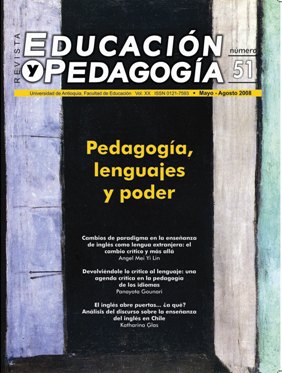A Literacy Model using information and communication technologies
Keywords:
Digital Literacy Teaching Model, Information and Communication Technologies, Learning and Teaching reading/ writing skillsAbstract
A proposal to develop literacy skills in expressing, communicating and managing information as well as interacting socially by effectively using some information and communication technologies are described here. Such technologies include tools for hypermedia writing, capturing and editing digital videos and photographs, e-forums and chats, videoconference, instant messenger systems, search engines in internet, e-mail, blogs, text editors and pages to publish in internet.
How to reference this article:
Henao Álvarez, Octavio y Doris Adriana Ramírez S., “Un modelo de alfabetización que incorpora el uso de tecnologías de información y comunicación”, Revista Educación y Pedagogía, Medellín, Universidad de Antioquia, Facultad de Educación, vol. XX, núm. 51, (mayo-agosto), 2008, pp. 225-239.
Received: january 2008
Accepted: march 2008
Downloads
References
Asociación Internacional de Lectura, 2001, “Integrating Literacy and Technology in the Curriculum”, Reading, [en línea], disponible en: http://www.reading.org/positions/technology.html, consulta: 10 de agosto de 2005.
Anderson-Inman, L. y M. A. Horney, 1998, “Transforming text for At-Risk Readers”, en: D. Reinking et al., eds., Handbook of Literacy and Technology. Transformations in a Post-Typographic World, Mahwah, NJ, Lawrence Erlbaum Associates, pp. 15-43.
Bagui, S., 1998, “Reasons for Increased Learning Using Multimedia”, Journal of Educational Multimedia and Hypermedia, vol. 7, núm. 1, pp. 3-18.
Bolter, J. D., 2001, Writing Space. Computers, Hypertext, and the Remediation of Print, Mahwah, NJ, Lawrence Erlbaum Associates.
Coiro, J., 2003, “Reading comprehension on the Internet: Expanding our understanding of reading comprehension to encompass new literacies”, The Reading Teacher, núm. 56, pp. 458-464.
Goldberg, A., Rusell, M. y Cook, A., 2003, “The Effect of Computers on Student Writing: A Metaanalysis of Studies from 1992 to 2002”, The Journal of Technology, Learning, and Assessment, vol. 2, num. 1, pp. 1-51.
Goldman, S. R., 1996, “Reading, writing, and learning in hipermedia environments”, en: H. van Oostendorp y S. de Mul, eds., Cognitive Aspects of Electronic Text Processing, Norwood, NJ, Ablex Publishing Corporation.
Hartman, D. K., 2000, “What will be the influences of media on literacy in the next millenium?”, Read. 281-282.
Henao Álvarez, O., 2002, Procesamiento cognitivo y comprensión de textos en formato hipermedial, Medellín, Editorial Universidad de Antioquia.
Henao Álvarez, O.; D. Ramírez Salazar y L. E. Giraldo López, 2001, “Desarrollo de habilidades de escritura en niños de educación basica primaria utilizando el correo electrónico”, en: Memorias I Coloquio Internacional y III Regional de la Cátedra Unesco para la lectura y la escritura en América Latina,Organizado por Unesco y la Universidad del Valle, Cartagena, Colombia, 9 al 15 de diciembre.
Henao Álvarez, O.; D. I. Chaverra, W. Bolívar B., D. L. Puerta y N. H. Villa, 2006, “La producción escrita mediada por herramientas informáticas. La calidad textual, el nivel de aprendizaje y la motivación”, Lectura y Vida. Revista Latinoamericana de Lectura, vol. 27, núm. 2, pp. 6-13.
Henao Álvarez, O. y L. E. Giraldo López, 1992, “Efectos del uso de un procesador de textos y gráficos en el desarrollo de habilidades de escritura de niños de sexto grado”, Revista Informática Educativa, vol. 5, núm. 1, pp. 23-34.
Kellner, D. M., 2004, “Revolución tecnológica, alfabetismos múltiples y la reestructuración de la educación”, en: I. Snyder, comp., Alfabetismos digitales. Comunicación, innovación y educación en la era electrónica, Granada, España, Consorcio para la enseñanza abierta y a distancia de Andalucía.
Landow, G. P., 1997, “¿Qué puede hacer el crítico?”, en: G. P. Landow, comp., Teoría del hipertexto, Barcelona,Paidós.
Leu, D. J.; C. K. Kinzer, J. L. Coiro y D. W. Cammack, 2004, “Toward a Theory of New Literacies Emerging from the Internet and Other Information and Communication Technologies”, en: R.B. Ruddell y
N. J. Unrau, eds., Theoretical models and processes of reading, Newark, DE, International Reading Association, pp. 1.570-1.613.
Najjar, L. J., 1996, “Multimedia Information and Learning”, Journal of Educational Multimedia and Hypermedia, vol 5, núm. 2, pp. 129-150.
Reinking, D. y R. Schreiner, 1985, “The effects of computer-mediated text on measures of reading comprehension and reading behavior”, Reading Research Quarterly, vol. 20, núm. 5, pp. 536-552.
Downloads
Published
How to Cite
Issue
Section
License

Esta obra está bajo una licencia de Creative Commons Reconocimiento-NoComercial-CompartirIgual 4.0 Internacional




